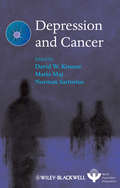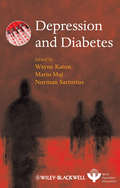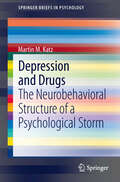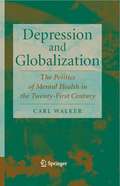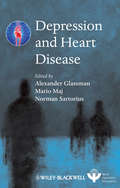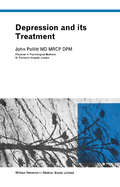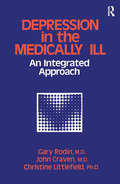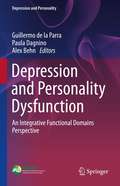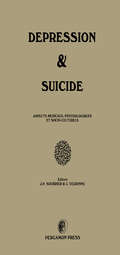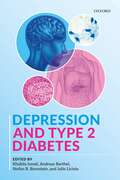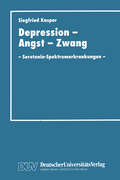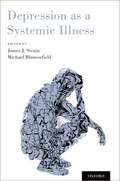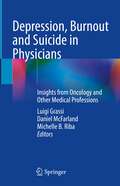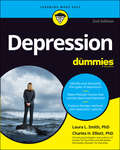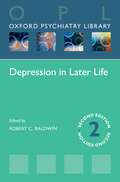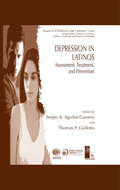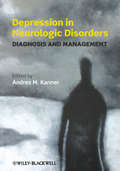- Table View
- List View
Depression and Cancer (World Psychiatric Association #14)
by David W. Kissane Norman SartoriusRecently, there has been a growing awareness of the multiple interrelationships between depression and cancer. Depression and Cancer is devoted to the interaction between these disorders. The book examines various aspects of this comorbidity and describes how the negative consequences of depression in cancer could be avoided or ameliorated, given that effective depression treatments for cancer patients are available. Renowned psychiatrists and oncologists summarize the latest evidence on the epidemiology, pathogenesis, screening and recognition, and cultural and public health implications of depression in persons with cancer, among other topics.
Depression and Diabetes (World Psychiatric Association #16)
by Wayne Katon Mario Maj Norman SartoriusIn recent years, there has been a growing awareness of the multiple interrelationships between depression and various physical diseases. The WPA is providing an update of currently available evidence on these interrelationships by the publication of three books, dealing with the comorbidity of depression with diabetes, heart disease and cancer. Depression is a frequent and serious comorbid condition in diabetes, which adversely affects quality of life and the long-term prognosis. Co-occurrent depression presents peculiar clinical challenges, making both conditions harder to manage. Depression and Diabetes is the first book devoted to the interaction between these common disorders. World leaders in diabetes, depression and public health synthesize current evidence, including some previously unpublished data, in a concise, easy-to-read format. They provide an overview of the epidemiology, pathogenesis, medical costs, management, and public health and cultural implications of the comorbidity between depression and diabetes. The book describes how the negative consequences of depression in diabetes could be avoided, given that effective depression treatments for diabetic patients are available. Its practical approach makes the book ideal for all those involved in the management of these patients: psychiatrists, psychologists, diabetologists, general practitioners, diabetes specialist nurses and mental health nurses.
Depression and Diabetes (World Psychiatric Association #13)
by Wayne Katon Mario Maj Norman SartoriusIn recent years, there has been a growing awareness of the multiple interrelationships between depression and various physical diseases. The WPA is providing an update of currently available evidence on these interrelationships by the publication of three books, dealing with the comorbidity of depression with diabetes, heart disease and cancer. Depression is a frequent and serious comorbid condition in diabetes, which adversely affects quality of life and the long-term prognosis. Co-occurrent depression presents peculiar clinical challenges, making both conditions harder to manage. Depression and Diabetes is the first book devoted to the interaction between these common disorders. World leaders in diabetes, depression and public health synthesize current evidence, including some previously unpublished data, in a concise, easy-to-read format. They provide an overview of the epidemiology, pathogenesis, medical costs, management, and public health and cultural implications of the comorbidity between depression and diabetes. The book describes how the negative consequences of depression in diabetes could be avoided, given that effective depression treatments for diabetic patients are available. Its practical approach makes the book ideal for all those involved in the management of these patients: psychiatrists, psychologists, diabetologists, general practitioners, diabetes specialist nurses and mental health nurses.
Depression and Drugs: The Neurobehavioral Structure of a Psychological Storm (SpringerBriefs in Psychology)
by Martin M. KatzThis book integrates the current state of knowledge on the association of neurochemical and psychological factors underlying the concept of depression or on the process and nature of the drug-induced changes that lead to recovery. Highlighting the results of two major multisite collaborative studies of the psychobiology of depression, the author demonstrates how more refined clinical methods uncover the initial behavioral actions of the drugs and chart the time course of their actions. The results disconfirm earlier textbook reported findings that these actions are delayed for several weeks beyond the almost immediate neurochemical effects. The “multivantaged” method makes possible distinguishing the clinical actions of different classes of antidepressant drugs.
Depression and Globalization: The Politics of Mental Health in the 21st Century
by Carl WalkerThis is an important academic text on the political aspects of depression, specifically the relationship between globalization and depression. The text Walker reestablishes the link between mental health research and treatment, along with the political and economical influences outside the world of academic and clinical mental health. Overall, this book accomplishes the task of how closely and inextricably linked these diverse fields are and the way they operate together to produce not only a cultural representation of mental illness but influence the extent and type of mental distress in the 21st century.
Depression and Heart Disease
by Alexander Glassman Mario M. Maj Norman SartoriusRecently, there has been a growing awareness of the multiple interrelationships between depression and various physical diseases. Patients with psychiatric problems, particularly depression, may be more susceptible to cardiovascular disorders. Depression and Heart Disease synthesizes current evidence, including some previously unpublished data, in a concise, easy-to-read format. The authors succinctly describe the epidemiology, pathogenesis (including cytokines and genetics), and risk factors of the comorbidity between depression and heart disease. The book also reviews the best pharmacological and psychotherapeutic approaches for people with this comorbidity.
Depression and Heart Disease (World Psychiatric Association Ser.)
by Alexander Glassman Mario Maj Norman SartoriusRecently, there has been a growing awareness of the multiple interrelationships between depression and various physical diseases. Patients with psychiatric problems, particularly depression, may be more susceptible to cardiovascular disorders. Depression and Heart Disease synthesizes current evidence, including some previously unpublished data, in a concise, easy-to-read format. The authors succinctly describe the epidemiology, pathogenesis (including cytokines and genetics), and risk factors of the comorbidity between depression and heart disease. The book also reviews the best pharmacological and psychotherapeutic approaches for people with this comorbidity.
Depression and Its Treatment
by John PollittDepression and its Treatment focuses on medical interventions in the diagnosis and treatment of depression, as well as identification of symptoms and possible mechanisms of treatment. The book first offers information on the concept and classification of depression, physiology and psychopathology, and clinical types of depression, including classification of depressive illnesses and etiology. The publication then takes a look at the treatment of psychological and physiological depression and complications of depression and their treatment. The text ponders on the prognosis of psychological and physiological depression and critique of existing terminology, as well as illustrative case histories of depression. The manuscript is highly recommended for clinicians and psychiatrists wanting to explore the approaches in the treatment of depression.
Depression And The Medically Ill: An Integrated Approach
by Gary Gary RodinDiscusses the relationship between depression and medical illness and the diagnosis and management of depression in the medically ill. Covers methodological issues related to assessment and diagnosis of depression and analyzes psychological, social and biological factors associated with depression.
Depression And The Medically Ill: An Integrated Approach
by Gary Gary RodinDiscusses the relationship between depression and medical illness and the diagnosis and management of depression in the medically ill. Covers methodological issues related to assessment and diagnosis of depression and analyzes psychological, social and biological factors associated with depression.
Depression and Personality Dysfunction: An Integrative Functional Domains Perspective (Depression and Personality)
by Guillermo de la Parra Paula Dagnino Alex BehnThis book analyses the clinical interaction between depression and personality dysfunction to help clinicians better understand and treat patients with complex depression. It proposes an innovative perspective to clinical work that moves away from a disorder-centered approach to a person-centered approach by analysing complex depression through the lens of functional domains related to personality functioning and applying Research Domain Criteria to diagnosis and treatment planning. By doing so, it aims to contribute to the development of precision psychotherapy by applying the principles of precision medicine to mental health care.The book is divided in two parts. Chapters in the first part review problems in five domains of personality dysfunction that drive complex depressive presentations – identity, affect regulation, self-other regulation, social dysfunction and self-criticism – and the neurobiological findings underlying them. In the second part, authors present integrative models of depression and personality dysfunction and their implications for diagnosis and treatment. Depression and Personality Dysfunction: An Integrative Functional Domains Perspective is a scientific and clinical guide for the understanding and treatment of patients with depression complicated by personality dysfunction. It will be a useful tool for clinicians looking for resources to develop a more person-centered and evidence-based approach to mental health care.
Depression and Suicide: Aspects Medicaux, Psychologiques et Socio-Culturels
by J. P. Soubrier J. VedrinneDepression and Suicide: Aspects, Medicaux, Psychologiques, ET Socio-Culturels covers the proceedings of the 11th Congress of the International Association for Suicide Prevention, held in Paris, France on July 1981. This book is organized into four parts encompassing 132 chapters.Part I deals with the epidemiological studies and transcultural aspect of depression and suicide. This part discusses the influence of sociocultural and environmental factors in depressive and suicidal behavior. Parts II and III explore the theories and clinical approaches in depression and suicide, especially among young people. These parts consider the biological and medical aspects, hospital settings, and survivors of depression and suicide. Part IV emphasizes the therapeutics, crisis interventions, and paraclinical investigations of these neurological problems. This book will be of value to physicians, psychologists, psychiatrists, and researchers.
Depression and Type 2 Diabetes
by Khalida Ismail Andreas Barthel Stefan R. Bornstein Julio LicinioType 2 diabetes is a major global health concern, and is predicted to affect between 10% to 25% of the world's population in the next 20 years. This epidemic is mostly attributed to ageing populations and unhealthy lifestyles. Thusly, understanding how the mind interacts with the body is essential in unlocking the psychological, biological, and sociocultural processes that increase the risk of type 2 diabetes and make it such a difficult condition to treat. Depression is a common co-morbid condition and when both conditions are present, this poses a significant challenge to patients, clinicians, and health care systems globally. Depression and Type 2 Diabetes is a unique resource offering a fresh scientific approach to this frequent co-morbidity. Using the latest research and guidelines, this resource provides readers with a comprehensive overview of the subject at the different stages of human lifespan, from the uterine environment where the metabolic thermostat is first set, to growing old with diabetes. Written and edited by international experts in diabetes and depression, Depression and Type 2 Diabetes reviews, critiques, and advances the latest research on the prevalent and complex relationship between depression and type 2 diabetes.
Depression and Type 2 Diabetes
Type 2 diabetes is a major global health concern, and is predicted to affect between 10% to 25% of the world's population in the next 20 years. This epidemic is mostly attributed to ageing populations and unhealthy lifestyles. Thusly, understanding how the mind interacts with the body is essential in unlocking the psychological, biological, and sociocultural processes that increase the risk of type 2 diabetes and make it such a difficult condition to treat. Depression is a common co-morbid condition and when both conditions are present, this poses a significant challenge to patients, clinicians, and health care systems globally. Depression and Type 2 Diabetes is a unique resource offering a fresh scientific approach to this frequent co-morbidity. Using the latest research and guidelines, this resource provides readers with a comprehensive overview of the subject at the different stages of human lifespan, from the uterine environment where the metabolic thermostat is first set, to growing old with diabetes. Written and edited by international experts in diabetes and depression, Depression and Type 2 Diabetes reviews, critiques, and advances the latest research on the prevalent and complex relationship between depression and type 2 diabetes.
Depression, Angst, traumatischer Stress und internistische Erkrankungen: Eine psychosomatische und somatopsychische Perspektive
by Hans-Peter KapfhammerKörperliche Erkrankungen gehen in ihrem Verlauf mit einer hohen psychischen Komorbidität einher. Vor allem eine koexistente Depression und Angst, ein chronischer oder traumatischer Stress üben einen relevanten negativen Einfluss auf das dynamische Krankheitsgeschehen aus. Sie sind nicht nur häufig mit einer erhöhten Morbidität, einer ungünstigeren Lebensqualität und belasteten psychosozialen Integration assoziiert. Sie sind oft auch mit einem erhöhten Mortalitätsrisiko und einem bedenkenswerten Suizidrisiko verbunden. Depression, Angst, chronischer und posttraumatischer Stress können auch die Entwicklung von körperlichen Krankheiten beeinflussen, indem sie allgemeine somatische Krankheitsrisiken vermitteln. Sowohl eine psycho-somatische als auch ein somato-psychische Perspektive ist notwendig, um die komplexen Interaktionen zwischen psychologischer, psychosozialer und biologischer Ebene zu erfassen. Ein allgemeiner Teil nimmt das Thema von psychischer und somatischer Komorbidität in einer bidirektionalen Wirkrichtung auf. Er befasst sich mit theoretischen Konzepten und empirischen Befunden zu möglichen Beziehungen zwischen somatischer Krankheit und medizinischer Behandlungsmodalität einerseits und psychischer Vulnerabilität und Störung andererseits, die traditionellerweise einer „psychosomatischen Perspektive“ in der Medizin zugeordnet werden. In einem speziellen Teil werden diese allgemeinen Aspekte einer biopsychosozialen Betrachtung von Depression, Angst und traumatischem Stress in ihrem potentiellen Einfluss auf definierte internistische Krankheitsrisiken bzw. von koexistenter depressiver, Angst- und posttraumatischer Belastungsstörung bei internistischen Erkrankungen in ihren möglichen Auswirkungen auf Krankheitsdynamik und Krankheitsverlauf jeweils nach traditionellen Organsystemen bzw. nach speziellen medizinischen Behandlungskontexten je gesondert dargestellt. Dieses umfangreiche Werk richtet sich gleichermaßen an die Kolleg*innen aus Psychiatrie und Psychotherapie wie aus den medizinischen Fächern, sowie an alle Leser*innen, die an einer psychosomatischen und somatopsychischen Perspektive auf die komplexen wechselseitigen Beziehungen zwischen psychischen Störungen und körperlichen Krankheiten interessiert sind.
Depression, Angst und traumatischer Stress in der Chirurgie: Eine psychosomatische und somatopsychische Perspektive
by Hans-Peter KapfhammerDieses Buch schließt unmittelbar an das „Vorgängerprojekt“ Depression, Angst, traumatischer Stress und internistische Erkrankungen (ISBN 978-3-662-65872-7) an. Ein allgemeiner Einführungsteil stellt das tragende Konzept der somatischen und psychischen Komorbidität dar und unterstreicht einen engen Zusammenhang von körperlichen Krankheiten, medizinischen, hier chirurgischen und anästhesistischen Interventionen und koexistenten depressiven, ängstlichen und (post-)traumatischen Störungen. In einem anschließenden Teil wird dieser biopsychosoziale Fokus dann auf allgemeine Aspekte von Interventionen in Chirurgie und Anästhesie in den prä-, intra- und postoperativen Abschnitten gerichtet. Diese Aspekte werden an den häufigsten Operationen in der Allgemeinchirurgie und Orthopädie veranschaulicht. Das Thema einer affektiven und Stress-bezogenen Komorbidität wird nachfolgend in einzelnen chirurgischen Spezialkontexten erneut aufgenommen, so in der Trauma- und Unfallchirurgie, der Herzchirurgie, der onkologischen Chirurgie, der Adipositaschirurgie sowie der Transplantationschirurgie. Das Buch richtet sich gleichermaßen an Kolleg*innen aus Psychiatrie, Psychosomatik, Psychotherapie und klinischer Psychologie wie auch an Kolleg*innen aus den medizinischen insbesondere den chirurgischen und anästhesistischen Fächern. Es ist auch für alle Personen von Interesse, die sich zu den komplexen psychosomatischen und somatopsychischen Themen in der Chirurgie und Anästhesie orientieren oder mit ihnen näher befassen wollen.
Depression as a Systemic Illness
by James J. StrainAlthough depression has been long considered an exclusively mental disorder, this book highlights the importance of recognizing it as a systemic--physical--illness. The chapters herein present key findings from research on animal models before proceding on to examine the "allostatic" load that depression bears on the body, commonly observed patterns of depression, and illnesses that it is likely to adversely effect--through mechanisms other than that of non-compliance with treatment. The authors also explore various diagnostic dilemmas including symptom-driven, phenomenologic approaches, and discuss drug-drug interactions and the use of unique electronic health records as collaborating agents to the physician. Depression as a Systemic Illness emphasizes the need for the primary care physician to be the first agent to care for "garden variety" depressive disorders and the need to alter medical school and residency training to accommodate the development of the necessary skills, knowledge and attitudes to fulfill this goal. Its unique approach and presentation of depression makes it a key resource for clinicians within the fields of both psychiatry and primary care medicine.
Depression as a Systemic Illness
Although depression has been long considered an exclusively mental disorder, this book highlights the importance of recognizing it as a systemic--physical--illness. The chapters herein present key findings from research on animal models before proceding on to examine the "allostatic" load that depression bears on the body, commonly observed patterns of depression, and illnesses that it is likely to adversely effect--through mechanisms other than that of non-compliance with treatment. The authors also explore various diagnostic dilemmas including symptom-driven, phenomenologic approaches, and discuss drug-drug interactions and the use of unique electronic health records as collaborating agents to the physician. Depression as a Systemic Illness emphasizes the need for the primary care physician to be the first agent to care for "garden variety" depressive disorders and the need to alter medical school and residency training to accommodate the development of the necessary skills, knowledge and attitudes to fulfill this goal. Its unique approach and presentation of depression makes it a key resource for clinicians within the fields of both psychiatry and primary care medicine.
Depression, Burnout and Suicide in Physicians: Insights from Oncology and Other Medical Professions
by Luigi Grassi Daniel McFarland Michelle B. RibaThis book provides a reference and contextual basis for depression, burnout and suicide among oncology and other medical professionals. Oncology as a medical subspecialty is at a unique apex of this crisis. While the same pressures in medicine certainly apply to oncologists, oncology is particularly stressful as a changing field with diverse patient and societal expectations for outcomes. In addition to experiencing the stress of caring for patients that could succumb to their cancer diagnoses, these professionals are regularly confronted with an onslaught of new medical information and a landscape that is changing at a breakneck pace. These are just a few factors involved in the increasing rates of burnout among oncologists as well as other medcial professionals. By addressing a gap in identifying mental health problems among health care professionals, this book sheds light on mental health problems and suicide among physicians. Importantly, this book is a call to action of the professional and administrative organizations to work on improving mental health of physicians. Anxiety and depression affect not only the individual doctor but also patient care. Given the increasing attention to these issues along with limited yet applicable data regarding how to address these issues, the text aims to bring the latest data face to face with consensus opinion and can be used to ultimately enhance oncologic and psychiatric practices. Written by experts in the field, Depression, Burnout and Suicide in Physicians: Insights from Oncology and Other Medical Professions aims to significantly increase awareness and contribute to understanding the necessity of preventive measures on individual, family, and care givers levels.
Depression For Dummies
by Laura L. Smith Charles H. ElliottThe good news on beating the blues Do you want the good, the bad, or the best news first? OK, the bad news is that an estimated 264+ million people worldwide suffer from a depressive illness. The good news is that we know how to defeat these illnesses better than ever before using a growing range of highly effective psychotherapies, medications, and other therapeutic methods that are improving all the time. And the best news: because of these advances, the majority of people no longer need to suffer the debilitating—and sometimes dangerous—effects of long-term depressive illness. The new edition of Depression For Dummies shows how you can make this happen for you by providing the latest and best information on how to banish the noonday demon and bring the sunshine back into your world. In this friendly, cheerful, no-nonsense guide, leading clinical psychologists Laura L. Smith and Charles H. Elliot give you the straight talk on what you face and proven, practical advice on how to punch back and win. Showing you how to know your enemy, they demystify common types of depression, explain its physical effects, and help identify the kind you have. Armed in this way, you can take firmer steps toward the lifestyle changes—as well as therapy or medication—that will put you back in control. Learn about different forms of depression Build simple, daily habits into your life that help banish the blues Understand conventional, alternative, and experimental therapies Move on: avoid relapses and stay happy! Whatever your level of depression—occasional bouts or long-term—this book gives you the insight, the tools, and the inner strength and persistence to put enjoyment back in your life.
Depression For Dummies (For Dummies Ser.)
by Laura L. Smith Charles H. ElliottThe good news on beating the blues Do you want the good, the bad, or the best news first? OK, the bad news is that an estimated 264+ million people worldwide suffer from a depressive illness. The good news is that we know how to defeat these illnesses better than ever before using a growing range of highly effective psychotherapies, medications, and other therapeutic methods that are improving all the time. And the best news: because of these advances, the majority of people no longer need to suffer the debilitating—and sometimes dangerous—effects of long-term depressive illness. The new edition of Depression For Dummies shows how you can make this happen for you by providing the latest and best information on how to banish the noonday demon and bring the sunshine back into your world. In this friendly, cheerful, no-nonsense guide, leading clinical psychologists Laura L. Smith and Charles H. Elliot give you the straight talk on what you face and proven, practical advice on how to punch back and win. Showing you how to know your enemy, they demystify common types of depression, explain its physical effects, and help identify the kind you have. Armed in this way, you can take firmer steps toward the lifestyle changes—as well as therapy or medication—that will put you back in control. Learn about different forms of depression Build simple, daily habits into your life that help banish the blues Understand conventional, alternative, and experimental therapies Move on: avoid relapses and stay happy! Whatever your level of depression—occasional bouts or long-term—this book gives you the insight, the tools, and the inner strength and persistence to put enjoyment back in your life.
Depression in Later Life (Oxford Psychiatry Library)
by Robert C. BaldwinDepression affects between 10-15% of older people, making it the most frequently encountered mental health condition in later life. Despite this, the condition is easily missed in clinical practice or not adequately treated. Part of the Oxford Psychiatry Library, this second edition of Depression in Later Life highlights areas of depression which are of special relevance to later life, how to diagnose depression in an older person, the overlap with dementia and various other physical illnesses, and important pharmacological and psychological considerations. All chapters have been updated with new data where relevant, and case vignettes are included to ensure the book is relatable and easy to read.
Depression in Latinos: Assessment, Treatment, and Prevention (Issues in Children's and Families' Lives #8)
by Thomas P. Gullotta Sergio A. Aguilar-GaxiolaDepression ranks as a leading mental health problem among Hispanic immigrants and their US-born children. And a wide array of issues - starting with the widespread stereotype of the “illegal immigrant” - makes the Latino experience of this condition differ from that of any other group. Depression in Latinos consolidates the conceptual, diagnostic, and clinical knowledge based on this salient topic, providing coverage from prevalence to prevention, from efficient screening to effective interventions. In this concise yet comprehensive volume, leading clinicians, researchers, and academics offer extensive research and clinical findings, literature reviews (e.g., an in-depth chapter on the Mexican American Prevalence and Services Survey), and insights gathered from first-hand experience in clinical practice. Perceptive information is offered on the most urgent and complex issues on depression in this diverse and dynamic population, including: (1) The impact language, culture, and societal factors have on depression and its diagnosis. (2) The most relevant assessment instruments. (3) How depression manifests among Latino children, youth, and seniors as well as in Latinas. (4) The relationship between depression and substance abuse. (5) The most effective evidence-based treatment methods. (6) The efficacy of interventions for depression at the community level. Depression in Latinos is vital reading for clinicians, counseling and school psychologists, psychiatrists, clinical social workers, and public health professionals interested in providing their Hispanic clients with the most effective treatment possible. In addition, its coverage of the broader issues of access to care makes this volume essential reading for mental health administrators, volunteer/outreach agencies, and policymakers.
Depression in Neurologic Disorders: Diagnosis and Management
by Andres KannerThe first part of the book begins with an overview of depression, its incidence and manifestations and neurobiological origins; how it's diagnosed; and its relevance to neurology, in particular to suicidality. The second part looks at depression in distinct conditions, in particular: migraine, stroke, epilepsy, Parkinson's Disease, Huntington's Disease, dementia, and traumatic brain injury. This useful guide takes a practical approach, with "tips and tricks" boxes, case studies, points of interest boxes, and take-home summaries.
